中国故宫(紫禁城)英文版详细介绍
- 格式:ppt
- 大小:8.07 MB
- 文档页数:43
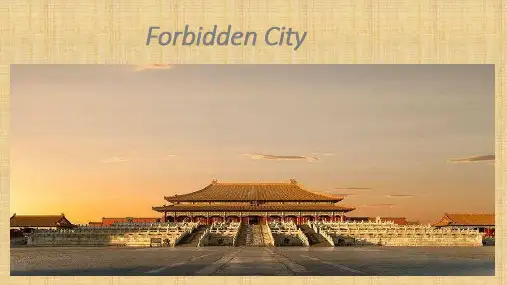
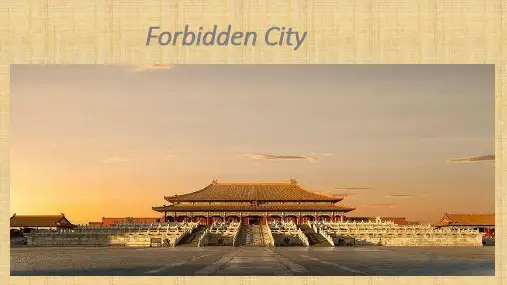
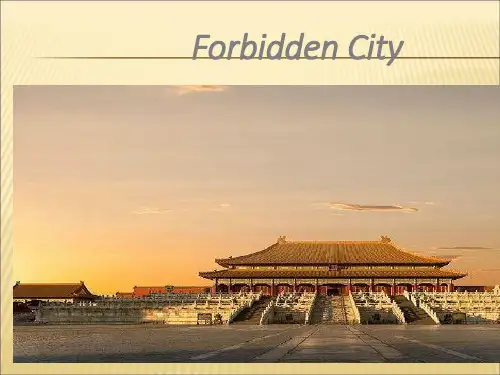
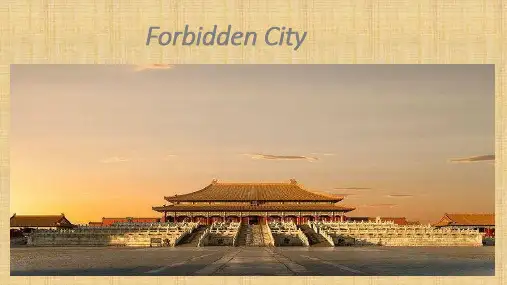
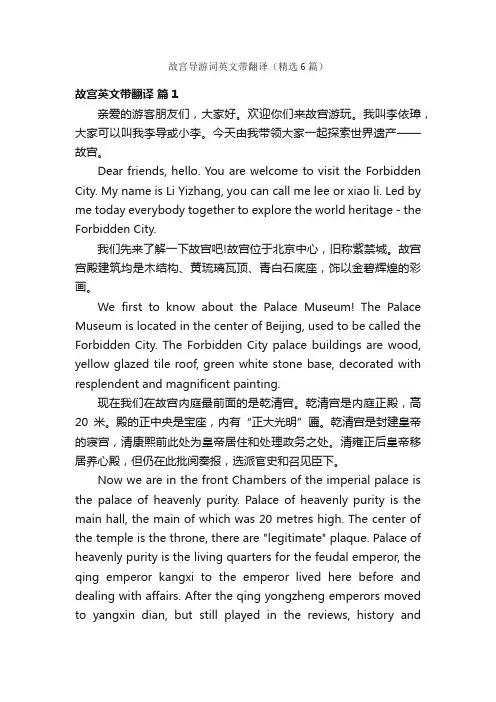
故宫导游词英文带翻译(精选6篇)故宫英文带翻译篇1亲爱的游客朋友们,大家好。
欢迎你们来故宫游玩。
我叫李依璋,大家可以叫我李导或小李。
今天由我带领大家一起探索世界遗产——故宫。
Dear friends, hello. You are welcome to visit the Forbidden City. My name is Li Yizhang, you can call me lee or xiao li. Led by me today everybody together to explore the world heritage - the Forbidden City.我们先来了解一下故宫吧!故宫位于北京中心,旧称紫禁城。
故宫宫殿建筑均是木结构、黄琉璃瓦顶、青白石底座,饰以金碧辉煌的彩画。
We first to know about the Palace Museum! The Palace Museum is located in the center of Beijing, used to be called the Forbidden City. The Forbidden City palace buildings are wood, yellow glazed tile roof, green white stone base, decorated with resplendent and magnificent painting.现在我们在故宫内庭最前面的是乾清宫。
乾清宫是内庭正殿,高20米。
殿的正中央是宝座,内有“正大光明”匾。
乾清宫是封建皇帝的寝宫,清康熙前此处为皇帝居住和处理政务之处。
清雍正后皇帝移居养心殿,但仍在此批阅奏报,选派官史和召见臣下。
Now we are in the front Chambers of the imperial palace is the palace of heavenly purity. Palace of heavenly purity is the main hall, the main of which was 20 metres high. The center of the temple is the throne, there are "legitimate" plaque. Palace of heavenly purity is the living quarters for the feudal emperor, the qing emperor kangxi to the emperor lived here before and dealing with affairs. After the qing yongzheng emperors moved to yangxin dian, but still played in the reviews, history andsummoned liegeman appointed officer.现在我们来到了坤宁宫,在故宫中间的是坤宁宫,雍正后,西暖阁为萨满的祭祀地。
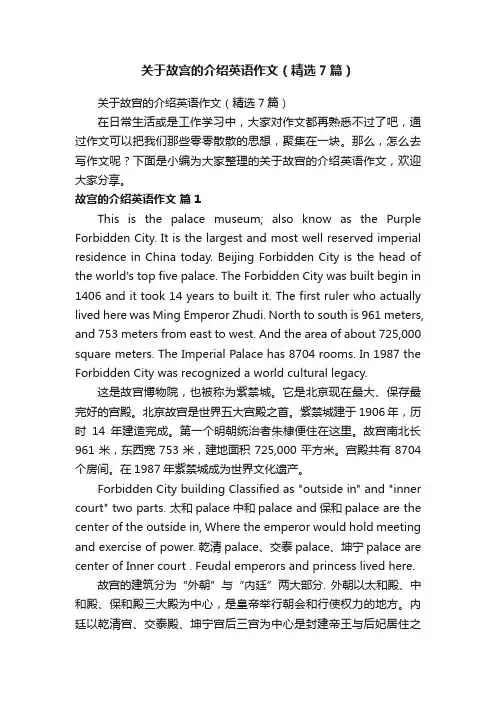
关于故宫的介绍英语作文(精选7篇)关于故宫的介绍英语作文(精选7篇)在日常生活或是工作学习中,大家对作文都再熟悉不过了吧,通过作文可以把我们那些零零散散的思想,聚集在一块。
那么,怎么去写作文呢?下面是小编为大家整理的关于故宫的介绍英语作文,欢迎大家分享。
故宫的介绍英语作文篇1This is the palace museum; also know as the Purple Forbidden City. It is the largest and most well reserved imperial residence in China today. Beijing Forbidden City is the head of the world's top five palace. The Forbidden City was built begin in 1406 and it took 14 years to built it. The first ruler who actually lived here was Ming Emperor Zhudi. North to south is 961 meters, and 753 meters from east to west. And the area of about 725,000 square meters. The Imperial Palace has 8704 rooms. In 1987 the Forbidden City was recognized a world cultural legacy.这是故宫博物院,也被称为紫禁城。
它是北京现在最大、保存最完好的宫殿。
北京故宫是世界五大宫殿之首。
紫禁城建于1906年,历时14年建造完成。
第一个明朝统治者朱棣便住在这里。
故宫南北长961米,东西宽753米,建地面积725,000平方米。
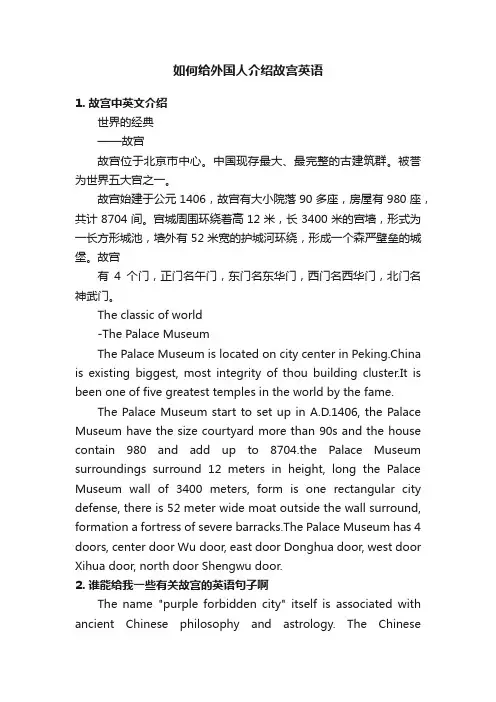
如何给外国人介绍故宫英语1. 故宫中英文介绍世界的经典——故宫故宫位于北京市中心。
中国现存最大、最完整的古建筑群。
被誉为世界五大宫之一。
故宫始建于公元1406,故宫有大小院落90多座,房屋有980座,共计8704间。
宫城周围环绕着高12米,长3400米的宫墙,形式为一长方形城池,墙外有52米宽的护城河环绕,形成一个森严壁垒的城堡。
故宫有4个门,正门名午门,东门名东华门,西门名西华门,北门名神武门。
The classic of world-The Palace MuseumThe Palace Museum is located on city center in Peking.China is existing biggest, most integrity of thou building cluster.It is been one of five greatest temples in the world by the fame.The Palace Museum start to set up in A.D.1406, the Palace Museum have the size courtyard more than 90s and the house contain 980 and add up to 8704.the Palace Museum surroundings surround 12 meters in height, long the Palace Museum wall of 3400 meters, form is one rectangular city defense, there is 52 meter wide moat outside the wall surround, formation a fortress of severe barracks.The Palace Museum has 4 doors, center door Wu door, east door Donghua door, west door Xihua door, north door Shengwu door.2. 谁能给我一些有关故宫的英语句子啊The name "purple forbidden city" itself is associated with ancient Chinese philosophy and astrology. The Chineseadvocated a mutual sensing between man and heaven or the integration of man and heaven. So, the structure of the Forbidden City is patterned after the legendary Heavenly Palace. Ancient Chinese astrologers divided the constellation into three parts, which were surrounded by 28 stars. Among them, the Purple Forbidden Enclosure (polar star) was thought to be in the center of the heaven, the center of all stars. Purple in the name refers to the star, meaning that the imperial court was the center of man under heaven. "Forbidden" refers to the living of the imperial family, which was deemed to have supreme dignity that cannot be encroached uponThe Forbidden City is worthy of the name of treasure of the Chinese nation in terms of both materials and architectural art and from its layout to its hidden meanings. Furthermore, it is a storehouse of numerous priceless handicrafts, rare curies, paintings and calligraphic works by famous artists, as well as official documents and historical records. In fact, the City is China's largest museum and biggest treasure houseInside the Forbidden City are more than 10 collection halls: the arts hall of all dynasties, the handicrafts and fine arts hall, the paintings hall, the toy hall of the imperial court of the Qing Dynasty, the bronze objects hall, the porcelain hall, timepiece hall, treasure hall, carvings hall and the hall of furniture of the Ming and Qing Dynasties. They contain about one million pieces, some of which are the only ones of their kind.A Tang Dynasty poet wrote a line about the royal palace of his time, which says “Without seeing the magnificence of the royal palace, one can n ever sense the dignity of the emperor”. Magnificent and awe-inspiring, that is how every visitor would describe the Forbidden City.3. 介绍故宫的英语作文20句话The Palace Museum is also called the Forbidden City,which started to be built in 1407.It took 200,000 people fourteen years to build it.It was finished in 1420.There are 9,999 rooms in all the palaces.In China,nine is regarded as a lucky number traditionally.At present,it is free for Chinese students to visit every Tuesday.The Palace Museum has treasures of over 5,000 years' history.。
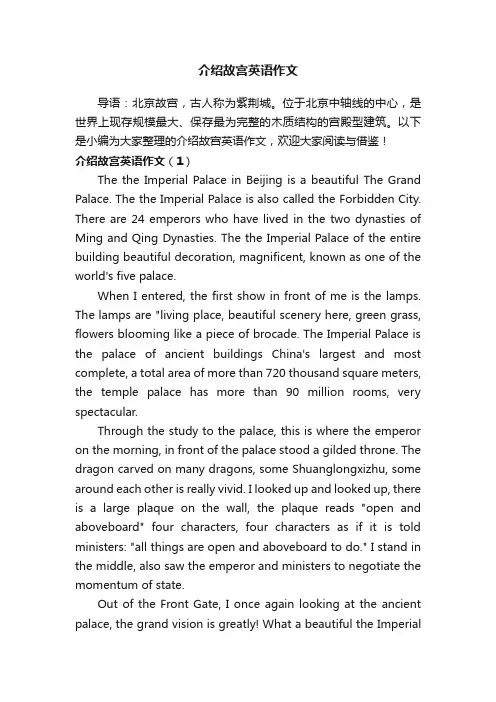
介绍故宫英语作文导语:北京故宫,古人称为紫荆城。
位于北京中轴线的中心,是世界上现存规模最大、保存最为完整的木质结构的宫殿型建筑。
以下是小编为大家整理的介绍故宫英语作文,欢迎大家阅读与借鉴!介绍故宫英语作文(1)The the Imperial Palace in Beijing is a beautiful The Grand Palace. The the Imperial Palace is also called the Forbidden City. There are 24 emperors who have lived in the two dynasties of Ming and Qing Dynasties. The the Imperial Palace of the entire building beautiful decoration, magnificent, known as one of the world's five palace.When I entered, the first show in front of me is the lamps. The lamps are "living place, beautiful scenery here, green grass, flowers blooming like a piece of brocade. The Imperial Palace is the palace of ancient buildings China's largest and most complete, a total area of more than 720 thousand square meters, the temple palace has more than 90 million rooms, very spectacular.Through the study to the palace, this is where the emperor on the morning, in front of the palace stood a gilded throne. The dragon carved on many dragons, some Shuanglongxizhu, some around each other is really vivid. I looked up and looked up, there is a large plaque on the wall, the plaque reads "open and aboveboard" four characters, four characters as if it is told ministers: "all things are open and aboveboard to do." I stand in the middle, also saw the emperor and ministers to negotiate the momentum of state.Out of the Front Gate, I once again looking at the ancient palace, the grand vision is greatly! What a beautiful the ImperialPalace!北京的故宫是个美丽的大皇宫。
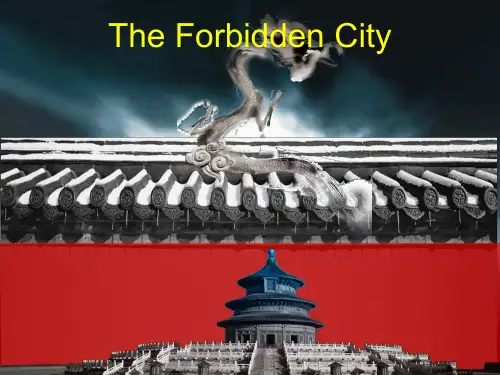
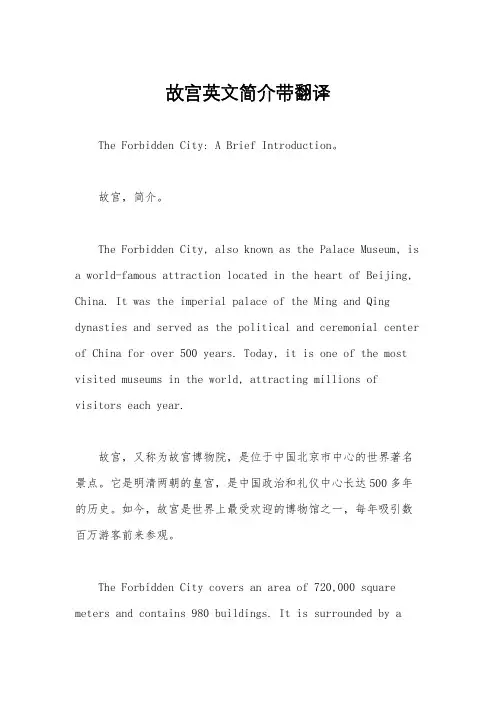
故宫英文简介带翻译The Forbidden City: A Brief Introduction。
故宫,简介。
The Forbidden City, also known as the Palace Museum, is a world-famous attraction located in the heart of Beijing, China. It was the imperial palace of the Ming and Qing dynasties and served as the political and ceremonial center of China for over 500 years. Today, it is one of the most visited museums in the world, attracting millions of visitors each year.故宫,又称为故宫博物院,是位于中国北京市中心的世界著名景点。
它是明清两朝的皇宫,是中国政治和礼仪中心长达500多年的历史。
如今,故宫是世界上最受欢迎的博物馆之一,每年吸引数百万游客前来参观。
The Forbidden City covers an area of 720,000 square meters and contains 980 buildings. It is surrounded by a52-meter-wide moat and a 10-meter-high wall. The palace complex is divided into two parts: the Outer Court, where the emperor held grand ceremonies and conducted state affairs, and the Inner Court, where the emperor and his family lived.故宫占地面积达72万平方米,包括980座建筑。
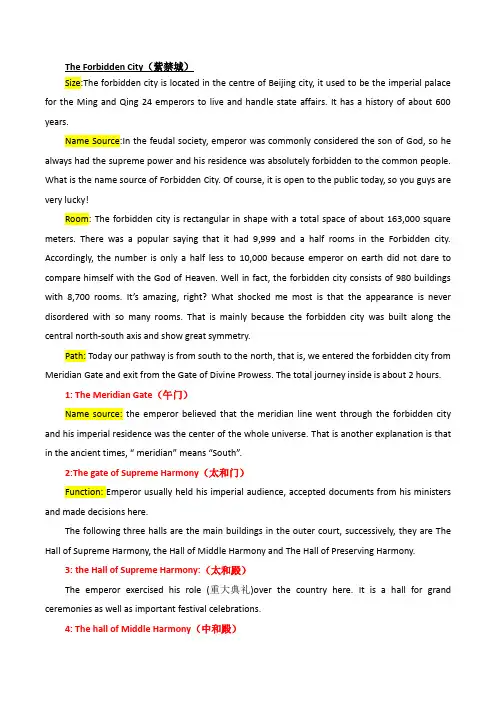
The Forbidden City(紫禁城)Size:The forbidden city is located in the centre of Beijing city, it used to be the imperial palace for the Ming and Qing 24 emperors to live and handle state affairs. It has a history of about 600 years.Name Source:In the feudal society, emperor was commonly considered the son of God, so he always had the supreme power and his residence was absolutely forbidden to the common people. What is the name source of Forbidden City. Of course, it is open to the public today, so you guys are very lucky!Room: The forbidden city is rectangular in shape with a total space of about 163,000 square meters. There was a popular saying that it had 9,999 and a half rooms in the Forbidden city. Accordingly, the number is only a half less to 10,000 because emperor on earth did not dare to compare himself with the God of Heaven. Well in fact, the forbidden city consists of 980 buildings with 8,700 rooms. It’s amazing, right? What shocked me most is that the appearance is never disordered with so many rooms. That is mainly because the forbidden city was built along the central north-south axis and show great symmetry.Path: Today our pathway is from south to the north, that is, we entered the forbidden city from Meridian Gate and exit from the Gate of Divine Prowess. The total journey inside is about 2 hours.1: The Meridian Gate(午门)Name source: the emperor believed that the meridian line went through the forbidden city and his imperial residence was the center of the whole universe. That is another explanation is that in the ancient times, “ meridian” means “South”.2:The gate of Supreme Harmony(太和门)Function: Emperor usually held his imperial audience, accepted documents from his ministers and made decisions here.The following three halls are the main buildings in the outer court, successively, they are The Hall of Supreme Harmony, the Hall of Middle Harmony and The Hall of Preserving Harmony.3: the Hall of Supreme Harmony:(太和殿)The emperor exercised his role (重大典礼)over the country here. It is a hall for grand ceremonies as well as important festival celebrations.4: The hall of Middle Harmony(中和殿)The name of Middle comes from the Confucius idea of “mean” and “impartial”. It is a place for the emperor to take a short rest. In Qing Dynasty, the emperor usually came here and examined the tools for ploughing(农耕)in spring time. Besides that, the emperor also held ceremony of presenting the genealogy revision and approval.5: the hall of Preserving Harmony(保和殿)It is a place for the emperor to have banquets to entertain the civil and military officials. Later in Qing Dynasty, emperor held the Imperial Palace examination here. Attention! There is no pillar in its front part.When you are walking through the Gate of Heavenly Purity(乾清门), you have entered the Inner Court.Resembling to the outer court, there are also three main buildings inside, the first one you are seeing is6:The palace of Heavenly Purity(乾清宫)In Ming and Early Qing Dynasty, emperors used to live here and handle the daily affairs. Later after emperor Yongzheng, it was changed to be an audience chamber for receiving foreign ambassadors and envoys form vassal states.8:the palace of Union and Peace(交泰殿)It is a place where the empress held the important ceremonies and her birthday celebration. in Qing Dynasty, the empress usually came here and examined the tools for picking mulberry in spring time.Name source: the name of this palace came from the book of Changes(ZHOU YI), which means the intercourse of heaven & earth, harmony of positive & negative, as well as the harmony between emperor & empress.7: The palace of Earthly Tranquility(坤宁宫)In Ming and Early Qing Dynasty, it was used as empress’s residence. Later ,the hall was completely reconstructed by imitating Qingning Palace(清宁宫) in Shenyang according to the Manchu’s custom.8:The Imperial Garden(御花园)it is about 12,000 square meters, containing more than 20 different types of buildings , pavilions, terraces etc. you can also see lots of pine trees, cypress trees and other botanies.Undoubtedly, the Imperial Garden is an ideal place for entertainment and relaxation.Ok, it is almost the end of our visit in the Forbidden city. You can have a 5 minutes short break here. The toilet is …….., please come back at…….The last spot is the Gate of Divine Prowess(神武门). Actually, the name of the gate was Xuanwumen at first, but when to Emperor Kangxi, as his name is Xuanye, the gate’s name had the same pronunciation with emperor’s name. You know, it was a serious taboo for mentioning the emperor’s name in ancient times. Hence the gate’s name was finally changed to “Shenwumen”.。
故宫英文导游词FORBIDDEN CITY(紫禁城)(In front of the meridian gate)Ladies and Gentlemen:I am pleased to serve as your guide today.This is the palace museum; also know as the Purple Forbidden City. It is the largest and most well reserved imperial residence in China today. Under Ming Emperor Yongle, construction began in 1406. It took 14years to build the Forbidden City. The first ruler who actually lived here was Ming Emperor Zhudi. For five centuries thereafter, it continued to be the residence of23 successive emperors until 1911 when Qing Emperor Puyi was forced to abdicate the throne .In 1987, the United Nations Educational, Scientific and Cultural Organization recognized the Forbidden City was a world cultural legacy.It is believed that the Palace Museum, or Zi Jin Cheng (Purple Forbidden City), got its name from astronomy folklore, The ancient astronomers divided the constellations into groups and centered them around the Ziwei Yuan(North Star). The constellation containing the North Star was called the Constellation of Heavenly God and star itself was called the purple palace. Because the emperor was supposedly the son of the heavenly gods, his central and dominant position would be further highlighted the use of the word purple in the name of his residence. In folklore, the term ‖an eastern purple cloud is drifting‖ became a metaphor for auspicious events after a purple cloud was seen drifting eastward immediately before the arrival of an ancient philosopher, LaoZi, to the Hanghu Pass. Here, purple is associated with auspicious developments. The word jin (forbidden) is self-explanatory as the imperial palace was heavilyguarded and off-explanatory as the imperial palace was heavily guarded and off-limits to ordinary people.The red and yellow used on the palace walls and roofs are also symbolic. Red represents happiness, good fortune and wealth. Yellow is the color of the earth on the Loess Plateau, the original home of the Chinese people. Yellow became an imperial color during the Tang dynasty, when only members of the royal family were allowed to wear it and use it in their architecture.The Forbidden City is rectangular in shape. It is 960 meters long from north to south and 750 meter wide from east west. It has 9,900 rooms under a total roof area 150,000 square meters .A 52-meter-wide-moat encircles a 9.9-meter—high wall which encloses the complex. Octagon —shaped turrets rest on the four corners of the wall. There are four entrances into the city: the Meridian Gate to the south, the Shenwu Gate(Gate of Military Prowess) to the north, and the Xihua Gate(Gate of military Prowess) to the north, and the Xihua Gate(Western Flowery Gate )to the west ,the Donghua (Eastern Flowery Gate) to the east.Manpower and materials throughout the country were used to build the Forbidden City.A total of 230,000 artisans and one million laborers were employed. Marble was quarried from fangshan Country Mount Pan in Jixian County in Hebei Province. Granite was quarried in Quyang County in Hebei Province. Paving blocks were firedin kilns in Suzhou in southern China. Bricks and scarlet pigmentation used on the palatial walls came from linqing in Shandong Province .Timber was cut ,processed and hauled from the northwestern and southern regions.The structure in front of us is the Meridian Gate. It is the main entrance to the forbidden City. It is also knows as Wufenglou(Five-Phoenix Tower). Ming emperorsheld lavish banquets here on the 15th day of the first month of the Chinese lunar year in hornor of their counties .They also used this place for punishing officals by flogging them with sticks.Qing emperors used this building to announce the beginning of the new year. Qing Emperor Qianglong changed the original name of this announcement ceremony from ban li(announcement of calendar)to ban shou(announcement of new moon )to avoid coincidental association with another Emperor` s name, Hongli, which was considered a taboo at that time. Qing Dynasty emperors also used this place to hold audience and for other important ceremonies. For example,when the imperial army returned victoriously from the battlefield ,it was here that the Emperor presided over the ceremony to accept prisoners of war.(After entering the Meridian Gate and standing in front of the Five Marble Bridges on Golden Water River)now we are inside the Forbidden City.Before we start our tour, I would like to briefly introduce you to the architectural patterns befour us .To complete this solemn, magnificent and palatial complex, a variety of buildings were arranged on anorth-south axis, and 8-kilometer-long invisible line that has become an inseparable part of the City of Beijing. The Forbidden City covers roughly one –third of this central axis. Most of the important building in the Forbidden City weree arranged along this line. The design and arrangement of the palaces reflect the solemn dignity of the royal court and rigidly –stratified feudal system.The Forbidden City is divided into an outer and an inner count.We are now standing on the southernmost part of the outer count. In front of us lies the Gate of supreme Harmony .The gate is guarded by a pair of bronze lions ,symbolizing imperial powerand dignity. The lions were the most exquisite and biggest of its kind. The one on the east playing with a ball is a male, and ball is said to represent state unity. Theother one is a female. Underneath one of its fore claws is a cub that is considered to be a symbol of perpetual imperial succession. The winding brook before us is the Golden Water River. It functions both as decoration and fire control .The five bridges spanning the river represent the five virtues preached by Confucius :benevolence, righteousness, rites, intellence and fidelity. The river takes the shape of a bow and the north-south axis is its arrow. This was meant to show that the Emperors ruled the country on behalf of God.(In front of the Gate of Supreme Harmony)The Forbidden City consists of an outer countyard and an inner enclosure. The out count yard covers a vast space lying between the Meridian Gate and the Gate of Heavenly Purity. The ―three big halls‖ of Supreme Harmony, Complete Harmony and Preserving Harmony constitute the center of this building group. Flanking them in bilateral symmetry are two groups of palaces: Wen hua (Prominent Scholars) and Wuying (Brave Warriors) . The three great halls are built on a spacious ―H‖-shaped,8-meter-high, triple marble terrace, Each level of the triple terrace is taller than the on below and all are encircled by marble balustrades carved with dragon and phoenix designs. There are three carved stone staircases linking the three architectures .The hall of supreme Harmony is also the tallest and most exquisite ancient wooden-structured mansion in all of China. From the palace of Heavenly Purith northward is what is known as the inner court, which is also built in bilaterally symmetrical patterns. In the center are the Palace of Heavenly Purity, the Hall of Union and Peace and Palace of Earthly Tranquility, a place where the Emperors lived with their families and attendedto state affairs. Flanking these structures are palaces and halls in which concubines and princes lived. There are also three botanical gardens within the inner count, namely, the imperial Garden, Caning garden and Quailing garden. An inner Golden Water River flows eastwardly within the inner court. The brook winds through three minor halls or palaces and leads out of the Forbidden City. It is spanned by the White Jade Bridge. The river is lined with winding, marble –carved balustrades. Most of the structures within the Forbidden City have yellow glazed tile roofs.Aside from giving prominence to the north-south axis, other architectural methods were applied to make every group of palatial structures unique in terms of terraces, roofs, mythical monsters perching on the roofs and colored, drawing patterns. With these, the grand contour and different hierarchic spectrum of the complex were strengthened. Folklore has it that there are altogether 9,999 room-units in the Forbidden City. Since Paradise only has 10,000 rooms, the Son of Heaven on earth cut the number by half a room. It is also rumoured that this half –room is located to the west of the Wenyuange Pavilion (imperial library). As a matter of fact, although the Forbidden City has more than 9,000 room-units, this half-room is nonexistent .The Wenyuange Pavilion is a library where ―Si Ku Quan Shu‖- China `s first comprehensive anthology-was stored.(After walking past the Gate of Supreme Harmony)Ladies and Gentlemen, the great hall we are approaching is the Hall of Supreme Harmony, the biggest and tallest of its king in the Forbidden City. This structure covers a total building space of 2,377 square meters, and is know for its upturned, multiple counterpart eaves . The Hall of Supreme Harmony sits on a triple ―H‖-shaped marble terrace the is 8meters high and linked by staircases. The staircase on theground floor has 21 steps while the middle and upper stairways each have 9.The construction of the Hall of Supreme Harmony began in 1406. It burned down three times and was severely damaged once during a mutiny. The existing architecture was built during the Qing Dynasty. On the corners of the eaves a line of animal-nails were usually fastened to the tiles. These animal-nails were later replace with mythical animals to ward off evil spirits. There are altogether 9 such fasteners on top of this hall. The number nine was regarded by the ancients to be the largest numeral accessible to man and to which only the emperors were entitled.There was a total of 24 successive emperors during the Ming and Qing dynasties who were enthroned here. The ball was also used for ceremonies which marked other great occasions: the Winter Solstice, The Chinese Lunar New Year, the Emperor` s birthday, conferral of the title of empress, the announcement of new laws and policies, and dispatches of generals to war .On such occasions, the Emperor would hold audiencefor his court officials and receive their tributes.This area is called the Hall of Supreme Harmony Square, which covers a total of30,000 square meters, Without a single tree or plant growing here, this place inspires visitors to feel its solemnity and grandeur. In the middle of the square there is a carriageway that was reserved for the Emperor. On both sides of the road the groud bricks were laid in a special way seven layers lengthwise and eight layers crosswise, making up fifteen layers in all. The purpose of this was to prevent anyone from tunneling his way into the palace. In the count yard there are iron vats for storing water to fight fires. In the whole complex there are altogher 308 water vats. In wintertime, charcoal was burned underneath the vats to keep the water from freezing .Why so vast a square? It was designed to impress people with the hall` s grandeur and vastness.Imagine the following scene. Under the clear blue sky, the yellow glazed tiles shimmered as the cloud-like layers of terrace, coupled with the curling veil of burning incense, transformed the hall of supreme Harmony into a fairyland. Whenever major ceremonies were held, the glazed, crane-shaped candleholders inside the hall would be it, and incense and pine branches burnt in front of the hall. When the Emperor appeared, drums were beaten and musical instrument played. Civilian officials and generals would kneel know in submission.The last Qing emperor Puyi assumed the throne in 1908, at the age of three, His father carried him to the throne. At the start of the coronation, the sudden drum-beating and loud music caught the young emperor unprepared .He was so scared that he kept crying and shouting,‖I don’t want to stay here. I want to go home.‖ His father tried to soothe him, saying, ‖It` all soon be finished .It` all soon be finished ‖The ministers present at the event considered this incident inauspicious. Coincidentally, the Qing dynasty collapsed three years later and there with concluded China `s feudal system that had lasted for more than 2,000 years.(On the stone terrace of the Hall of Supreme Harmony)This is a bronze incense burner. In it incense made of sandalwood would be burnt on important occasions. There are altogether 18 incense burners, representing all of the provinces under the rule of the Sing monarchs. On either side of the Hall, 4 bronze water-filled vats were placed in case of fire. Next to the terrace on either side, there is a bronze crane and tortoise, symbols of longevity. This copper-cast grain measure is called ‖jialiang.‖ It served as the national standard during the Qing dynasty. It was meant to show that the imperial ruler were just and open to rectification. On the other side there is a stone sundial, an ancient timepiece. The jialiang and the sundial wereprobably meant to show what the Emperor represented: that he was the only person who should possess the standards of both measure and time.In the very forefront of the Hall of Supreme Harmony , there are 12 scarlet , round pillars supporting the roof. The hall is 63 meters from east to west and 37 meters from north to south, It is 35 meters in height. In front of this architechture, there stands a triple terrace with five staircases leading up to the main entrance .It has 40 gold doors and 16 gold-key windows with colored drawings on the pillars and beams. In the middle of the hall, a throune carved with 9 dragons sits on a 2-meter-high platform. Behind the throne there is a golden screen and in front of it, there is a imperial desk . The flanks are decorated with elephants, Luduan(a legendary beast), cranes, and incense barrels. The elephant carries a vase on its back that holds five cereals(i. e. rice, two kinds of millet, wheat and beans),which was considered a symbol of prosperity. As ancient legend has it that luduan can travel 18,000 li (9,000 kilometers )in one day and knows all languages and dialects. Only to a wise adjust monarch will this beast be a guardian.The Hall of Supreme Harmony is also popularly known as Jinluan Dian (gold bell hall or the throne hall). The floor of the hall is laid with bricks that turn it into a smooth, fine surface as if water has been sprinkled on it .The so-called golden brick, in fact, has nothing to do with gold. Reserved exclusively for the construction of the royal court, it was made in a secretive, and complex way, and, when struck, sounds like the clink of a gold bar. Each brick was worth the market price of one dan (or one hectoliter ) of rice.The hall is supported by a total of 72 thick pillars .Of these, 6 are carved in dragon patterns and painted with gold and surround the throne. Above the very center of thishall there is a zaojing, or covered ceiling, which is one of the Specialities of China `s ancient architure. In the middle of the ceiling is a design of a dragon playing with a ball inlaid with peals. This copper ball, hollow inside and covered with mercury, is known as the Xuanyuan Mirror and is thought to be made Xuanyuan, a legendary monarch dating back to remote antiquity. The placing of the caisson above the throne is meant to suggest that all of China` s successive emperors are Zuanyuan` s descendants and hereditary heirs. Now you might have noticed that the Xuanyuan mirror is not directly above the throne. Why? It is rumored that Yuan Shikai, aself-acclaimed warlord-turned emperor moved the throne further back because he was afraid that the mirror might fall on him .In 1916 when Yuan Shikai became emperor, he removed the original throne with a Western-style, high-back chair. After the foundation of the People` s Republic of China in 1949 the throne was found in a shabby furniture warehouse. It repaired and returned to the hall.(Leading the tourist to the bronze vats either on the east or the west)the water vats in front of the palaces or house were called ―menhai,‖ or sea before the door by the ancient Chinese. They believed that with a sea by the door, fire could not wreak havoc. The vats served both as a decoration and as a fire extinguisher. They were kept full of water all year round.During the Qing Dynasty, they were altogether 308 vats in the palace enclosure. They were made of gilt bronze or iron. Of couse, the gilt bronze vats were of the best quality. When the allied forces (Britain, Germany, France, Russia, the United States,Italy, Japan and Austria) invaded Beijing in 1900 under the pretext of suppressing the Boxer Rebellion, the invaders ransacked the imperial compound and scraped and gold off the vats with their bayonets. During the Japanese occupation of Beijing, many vatswere trucked away by the Japanese to be made into bullets .(In front of the Hall of Complete Harmony)The square architecture before us is called the Hall of Complete Harmony. It served as an antechamber. The Emperor came here to meet with his countiers and add his final touches to the prayers which would be read at the ancestral Temple. The seeds, snowers and prayer intended for spring sowing were also examined here. The two Qing sedan chairs here on display were used for traveling within the palace during the reign of Emperor Qianlong.(In front of the hall f Preserving Harmony)this is the Hall of Preserving Harmony. During the Qing Dynasty, banquets were held here on New Year` s eve in honour of Mongolian and Northwestern China` s xingjiang princes and ranking officials. The Emperor also dinned here with his new son-in-law on the wedding day. Imperial examinations were also held here once every three years. During the Ming and Qing dynasties, there were three levels of exams: the county and prefectural level, the provincial level and national level. The national exam was presided over by the emperor. The civil service exam in ancient China started during the Han Dynasty. It served the purpose of recruiting Confucian scholars to the ministers and high officials. During the Tang and Qing dynasties reinstituted and ancient system. Once every three years, three hundred scholars from all over the country came to Beijing and took exams for three day and night. This system was abolished in 1905.(Behind the hall of preserving harmony)this is the largest stone carving in the palace . It is 16.73 meters long, 3.07 meters wide and 1.7 meters thick .It weighs about 200 tons. The block was quarried in FangshanCounty, roughly 70 kilometers away. To transport such a huge block to Beijing, laborers dug wells along the roadside half a kilometer apart, and used the groundwater to make a road of ice in the winter. Rolling blocks were used in the summer. In 1760, Emperor Qianlong of the Qing Dynasty ordered the carving of the existing cloud and dragon design in place of the old one which dated back to the Ming Dynasty.Note : From here, the tour can be conducted via three different routes: a western route(Route A), a central route (Route B) or an eastern route (Route C) .The commentary for each follows.Route ALadies and Gentlemen:You have seen the three main halls of the Forbidden City. Now I ` d like to show you around the hall of mental cultivation and the imperial garden . The hall of mental cultivation is situated is in the western part of the innermost enclosure and is symmetrical to Fengxian (enshrinement of forebears) Hall in the east. This hall was built during the Ming Dynasty. IT is a H-shaped structure consisting of an antechamber and a main building .The hall is surrounded by corridors. In front of the hall is the Office of Privy Council.Before Emperor Kangxi of Qing the Dynasty came to power the Hall of Heavenly Purity served as the living quarter of the emperors. Emperor Yongzheng chose to live in this hall and attended to every day state affairs from here .For the sake of protecting cultural relics, this hall is not open to the public .You can have a look at the inside from the door. The central hall was the audience chamber where the emperor read memorials, granted audience to officials and summoned his minsters for consultation. The western chamber of the hall was where the emperor read reports and discussedmilitary and political affairs. The hall consists of many inner rooms and is decorated with images of Buddha and miniature pagodas. On the screen wall there hangs a picture of two emperors in the Han costume. In a southern room there three rare calligraphic scrolls, hence the name of the room ―Sanxitang‖ (Room of Three Rare Treasures) . The room on the eastern side is of historical interst because it was here that Empress Dowager Cixi usurped power and made decisions on behalf of the young emperor . A bamboo curtain was used to separate them .Empress Dowage Cixi was born in 1835 in Lu` an Prefecture of shanxi province. She` s of Manchurian nationality and her father was a provincial governor from south China. When she was 17 years old ,she was selected to become a concubine of Emperor Xianfeng and moved into the Forbidden City. She gave birth to a son when she was21years old and was made a concubine the following year. When the emperor passed away in the summer of 1861, her son ascended the throne and title of Cixi, meaning―Holy Mother‖ was conferred upon her and she became the Empress Dowager. In that same year Empress Dowager Cixi carried out a count coup d` etatand ruled behind the scenes with another empress dowager, Ci` an, for 48 years. She passed away in 1908 at the age of 73. It was in reference to this situation that the term ―attending to state affairs behind a bamboo curtain‖ developed .In 1912 , Empress dowager Longyu declared the abdication of the last Qing emperor Puyi. They were allowed to remain in the Forbidden City for the next 13 years .The royal family was forced to move out permanently in 1924.Behind the central hall were the living accommodation of 8 successive Qing emperors .Three of them actually passed away here. The side rooms flanking the hall were reserved for empresses and concubines. Now let` s continue with our tour. It willtake us to the Hall of heavenly purity , the hall of union and peace ,the palace of earthly tranquility, and the imperial garden.Route B(Inside the Hall of heavenly Purity)Ladies and Gentlemen:We are now entering the inner court. From the Gate of Heavenly Purity northward lies the inner court where the emperors and empresses once lived .The Hall of heavenly Purity is the central hall of the inner court ,and was completed during the Reign of Emperor Yongle of the Ming Dynasty. There are 10 pillars supporting the entire structure and the hall is 20 meters in height .In the center of the hall there a throne. Above it hangs a plaque with an inscription that reads ―Be open and above-board,‖ written by Shenzhi,the first emperor of the Qing Dynasty. Beginning with Qianlong` s reign, the name of the successor to the throne was not publiclyannounced .instead, it was written on two pieces of paper, one to be kept on the emperor` s person throughout his reign, and the other placed in a small strongbox that was stored behind his plaque. The box was opened only after the emperor passed away. Altogether there where 4 emperors who ascended the throne in this way, namely Qianlong, Jiaqing, Daohuang and Xian feng.The hall of heavenly purity was where the emperors lived during the Ming and Qing dynasties. According to tradition ,extravagant annual banquets were held here on New Year` s Eve in honour of royal family members. Foreign ambassadors were received here during the late-Qing period. Two important ―one thousand old men` s feasts‖ of the Qing Dynasty were also held here. All the invitees had to be at least 65 years of age. This hall was also used for mourning services.(Inside the Palace of Union and Peace)this hall sits between the Hall of heavenly Purity and the Palace of Earthly Tranquility, symbolizing the union of heaven and earth ,as well as national peace .It was first built in 1420 and reconstructed in 1798. The hall is square in shape ,and is smaller than the Hall of complete Harmony .You will see a plaque here inscribed with two Chinese characters, wu wei, which were handwritten by Emperor Qianglong. A throne sits in the middle of the hall with a screen behind it .Above the throne there hangs a caisson ,or covered ceiling. The emperor held birthday celebrations and other major events here.In 1748 during Emperor Qianlong` s reign, 25 jade seals representing imperial authority were kept in this hall .No seals were allowed out of the room without the prior consent of the emperor. On each flack there is a water clock and a chiming clock. (Inside the palace of earthly tranquility)This used to be the central hall where successive Ming empresses lived. During the Qing dynasty, it was converted into a place where sacrifices and wedding ceremonies were held .The room on the western side was used for sacrifices and the room on the east was the seeding chamber.Route CLadies and Gentlemen:You have seen the three main halls of the Forbidden City. Now I` d like to show you around scenes of interest along the eastern route. The first is the Treasure Hall. This mansion is called the Hall of Imperial Zenith. This is where Sing Emperor Quailing lived after abdication. Nearly 1,000 artifacts and treasures are on display here, among which the Golden Hair Tower is one of the most famous. This tower is 1.53meters inheight and its base is 0.53 meters in circumference .It was built under the order of Emperor Quailing to be used to collect fallen hair in commemoration of his mother. There is also a ―Day harnessing Water Jade Hill ‖ on display here. Yu was a legendary monarch of the remote Ixia dynasty. Under his leadership, the people learned how to harness the Yellow River. This jade assemblage, 224 centimeters in height and 5 tons in weight, is the largest jade artwork in China. This mat was woven with peeled ivory. These artifacts are among China` s rarest treasures.(In front of the Nine-Dragon Screen)this is the Nine-Dragon Relief Screen .Erected in 1773,it is 3.5 meters in height and 29.4 meters in width. Underneath is a foundation made of marble .The surface of the screen is laid with a total of 270 colored, glazed tiles in the design of 9 dragons ,some rocky mountains ,clouds and the sea. It was meant to ward off evil spirits The ancient Chinese regarded 9 dragons, some rocky mountains, clouds and the sea. It was meant to ward off evil spirits .The ancient Chinese regarded 9 as the largest numeral and the dragon as a auspicious beast .The 9 dragons are different in color and posture and all are made of glazed tiles. Interestingly a piece of the third dragon from the left is made of wood. It is believe that when the Nine-dragon Screen was almost finished ,a piece of glazed tile was damaged .Emperor Qianlong was scheduled to inspect the work the following day .Using quick wits, the craftsman in question molded the missing piece with clay and sailed through the imperial inspection. Later ,he asked a carpenter to carve a wooden one to replace the one made of clay.(Approaching the Imperial Garden)Behind the Palace of Earthly Tranquility and trading the north-south axis is the imperial Garden. There are old trees, rare flowers and exotic rock formation in thisgarden .It cover a space of 11,700 square meters, or roughly 1.7 percent of the Forbidden City. Most of the structures in the garden are symmetrically arranged . However, each is different in terms of parrern and decoration. Woods clumps of bamboo screen off the garden and strengthens its deep and serene atmosphere.There main structure of the Imperial Garden is the Qin` an Hall. Positioned in the central-northern part of the garden ,this hall is flanked by other halls and pavilions on the east and west. The hall sits on a marble pedestal. The Taoist deity of Zhenwu is enshrined here and emperor would pay homage here a quarterly basis. Taoist rites were held during the reign of Emperor Jiajing of the Ming Dynasty. In front of the hall there is a cypress that is 400 years old .In all there are a dozen such rare trees in the garden, and most of them are cypresses or pines. To the northwest of the hall , there is the Yanhui(Sustaining Sunshine) Pavilion and to the northeast there lies the Duixiu (Accumulated Refinement )Hill. This Hill was built over the foundation of the long- pershed Guanhua (Admiring Flowers) Hall of the Ming Dynasty. It is 14 meters in height and made of al kinds of rocks quarried in jiang su province. At its base stand two nstone lions, each carrying a dragon shooting water 10 meters up into the air from its mouth. There are meandering paths leading to the hilltop. At the top of Duixiu Hill sits the Yujing (Imperial Viewing)Pavilion. Traditionally, On the day of the Double Ninth Festival (the ninth day of the ninth lunar month ), the emperor ,his consort, and his concubines would climb up to Yujing Pavilion to enjoy the scenery. At the southeastern corner of the Garden is Jiangxue(Crimson Snowy) Verandah. Nearby to the southwest lies Yangxing Study (study of the cultivation of nature) .The yangxing study was used as a royal library during the reign of Emperor Qianlong of the Qing Dynasty. The last emperor of the Qing Dynasty, Puyi once studied English there. In。
故宫介绍英语故宫介绍英语如下:The Palace Museum is located on city center in Peking.China is existing biggest,most integrity of thou building cluster.It is been one of five greatest temples in the world by the fame.The Palace Museum start to set up in A.D.1406,the Palace Museum have the size courtyard more than 90s and the house contain 980 and add up to 8704.the Palace Museum surroundings surround 12 meters in height,long the Palace Museum wall of 3400 meters,form is one rectangular city defense,there is 52 meter wide moat outside the wall surround,formation a fortress of severe barracks.The Palace Museum has 4 doors,center door Wu door,east door Donghua door,west door Xihua door,north door Shengwu door.故宫位于北京市中心.中国现存最大、最完整的古建筑群.被誉为世界五大宫之一.故宫始建于公元1406,故宫有大小院落90多座,房屋有980座,共计8704间.宫城周围环绕着高12米,长3400米的宫墙,形式为一长方形城池,墙外有52米宽的护城河环绕,形成一个森严壁垒的城堡.故宫有4个门,正门名午门,东门名东华门,西门名西华门,北门名神武门.。
故宫介绍导游词英文故宫介绍导游词英文导语:明清的两代皇宫,也叫“紫禁城”。
它始建于1406年,距今已有600年了。
以下小编为大家介绍故宫介绍导游词英文文章,欢迎大家阅读参考!故宫介绍导游词英文1Lying at the center of Beijing, the Forbidden City, called Gu Gong, in Chinese, was the imperial palace during the Ming and Qing dynasties. Now known as the Palace Museum, it is to the north of Tiananmen Square. Rectangular in shape, it is the world‘s largest palace complex and covers 74 hectares. Surrounded by a six meter deep moat and a ten meter high wall are 9,999 buildings. The wall has a gate on each side. Opposite the Tiananmen Gate, to the north is the Gate of Devine Might (Shenwumen), which faces Jingshan Park. The distance between these two gates is 960 meters, while the distance between the gates in the east and west walls is 750 meters. There are unique and delicately structured towers on each of the four corners of the curtain wall. These afford views over both the palace and the city outside. The Forbidden City is divided into two parts. The southern section, or the Outer Court was where the emperor exercised his supreme power over the nation. The northern section, or the Inner Court was where he lived with his royal family. Until 1924 when the last emperor of China was driven from the Inner Court, fourteen emperors of the Ming dynasty and ten emperors of the Qing dynasty had reigned here. Having been the imperial palace for some five centuries,it houses numerous rare treasures and curiosities. Listed by UNESCO as a World Cultural Heritage Site in 1987, the Palace Museum is nowone of the most popular tourist attractions world wide.Construction of the palace complex began in 1407, the 5th year of the Yongle reign of the third emperor of the Ming dynasty. It was completed fourteen years later in 1420. It was said that a million workers including one hundred thousand artisans were driven into the long-term hard labor. Stone needed was quarried from Fangshan, a suburb of Beijing. It was said a well was dug every fifty meters along the road in order to pour water onto the road in winter to slide huge stones on ice into the city. Huge amounts of timber and other materials were freighted from faraway provinces. Ancient Chinese people displayed their very considerable skills in building the Forbidden City. Take the grand red city wall for example. It has an 8.6 meters wide base reducing to 6.66 meters wide at the top. The angular shape of the wall totally frustrates attempts to climb it. The bricks were made from white lime and glutinous rice while the cement is made from glutinous rice and egg whites. These incredible materials make the wall extraordinarily strong.Since yellow is the symbol of the royal family,it is the dominant color in the Forbidden City. Roofs are built with yellow glazed tiles; decorations in the palace are painted yellow; even the bricks on the ground are made yellow by a special process. However, there is one exception. Wenyuange, the royal library,has a black roof. The reason is that it was believed black represented water then and could extinguish fire.Nowadays, the Forbidden City, or the Palace Museum is open to tourists from home and abroad. Splendid painted decoration on these royal architectural wonders, the grand and deluxe halls,with their surprisingly magnificent treasures will certainly satisfy "modern civilians".故宫介绍导游词英文2FORBIDDEN CITY (紫禁城)(In front of the meridian gate)Ladies and Gentlemen:I am pleased to serve as your guide today.This is the palace museum; also know as the Purple Forbidden City. It is the largest and most well reserved imperial residence in China today. Under Ming Emperor Yongle, construction began in 1406. It took 14years to build the Forbidden City. The first ruler who actually lived here was Ming Emperor Zhudi. For five centuries thereafter, it continued to be the residence of23 successive emperors until 1911 when Qing Emperor Puyi was forced to abdicate the throne. In 1987, the United Nations Educational, Scientific and Cultural Organization recognized the Forbidden City was a world cultural legacy.It is believed that the Palace Museum, or Zi Jin Cheng (Purple Forbidden City), got its name from astronomy folklore, The ancient astronomers divided the constellations into groups and centered them around the Ziwei Yuan (North Star) . The constellation containing the North Star was called the Constellation of Heavenly God and star itself was called the purple palace. Because the emperor was supposedly the son of the heavenly gods, his central and dominant position would be further highlighted the use of the word purple in the name of his residence. In folklore, the term “an eastern purple cloud is drifting” became a metaphor for auspicious events after a purple cloud was seen drifting eastward immediately before the arrival of an ancient philosopher, LaoZi, to the Hanghu Pass. Here, purple is associated with auspicious developments. The word jin (forbidden) is self-explanatory as the imperial palace was heavilyguarded and off-explanatory as the imperial palace was heavily guarded and off-limits to ordinary people.The red and yellow used on the palace walls and roofs are also symbolic. Red represents happin。